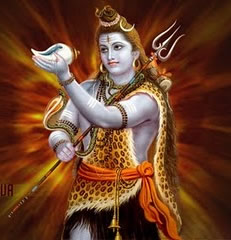SHIVA PURANA |
|
 |
Steps towards Salvation Bhagavan Siva revealed to Lord Vishnu who in turn informed Brahma and further down to Sanat Kumaras to Maharshi Narada and Vyasa that the steps to Salvation are basically four-fold viz. Sarupya (Resemblance of Paramathma), Salokya (Being in the sphere of Paramatma) Sannidhya (Proximity to Paramatma) and Sayujya (Union with Paramatma). Lords Brahma and Vishnu could certainly bestow the first Three Purusharthas viz. Dharma, Artha and Kama, or Virtuosity, Wealth and Worldly Desires respectively. But granting Moksha or Salvation is in the competence of Bhagavan Siva alone. |
He could also bestow Kaivalya or the Ultimate Stage, the knowledge of Siva Tatvam or Vilakshana / Nirguna Kind of Uniqueness which is not fully known to Brahma or Vishnu, Kumara and the Entirety of Maharshis. Siva Tatvam is described by Veda Vyasa as: On an enquiry about the variety of manifestations of Paramatma (The Greatest Soul), the doubt of identity of The Super Soul was whether of Brahma or Vishnu and Siva. Muni Sutha replied that at the Time of Creation, Paramatma had neither a form, nor Gunas (Physical Attributes) and nor name. That Supersoul was loosely called Siva. That Siva or Purusha was in Self- Union the Prakrithi. Together, they performed Tapasya or concentration in a huge ocean and that Sacred Place was known as ‘Pancha Kosas’ or the Five Sheaths. [Annamaya Kosa or Physical Body; Pranamaya Kosa or Prana /Linga Sarira or Vital Astral Sarira; Manonmaya Kosa or the lower Manas or Mind; Vijnana Maya Kosa or Higher Manas Kosa and finally Anandamaya Kosa corresponding to the Spiritual Soul or Buddhi] The Sixth Kosa enclosing the Pancha Kosas is Divine Atman. The Union of Siva and Prakrithi both created Hari Narayana (‘Nara’ being water) or who was spread over the huge water. From Narayana’s navel stood up a Lotus Stem and over the Flower was created Brahma. As there was conflict among the Trimurthis seeking inter -se superiority, Siva presented Himself as Maha Deva. He assured that all the manifes -tations of Himself were equally powerful and each of them was capable of giving boons to their devotees as well. They are like the same gold base but moulded into different ornaments. It was only notional that the tasks of Srishti, Sthithi and Laya were self assigned but each one of the Murthis is eqaully responsible. Similarly, there is no distinction between Siva and Rudra. Siva explained that Brahma created Rudra to perform the specific task of ‘Laya’, where as the Original and Unique Self, Siva is the Super Soul or Paramatma responsible for everything. Rudra is always prayed to but never prays to any body. Whoever prays to Lord Rudra, the strength and fruits of the Prayers are automatically transferred to Siva. |
|
| Shiva Purana Home |  |
Next: Siva Gyan ¢ Its Import and the Course |
Back to the News Page